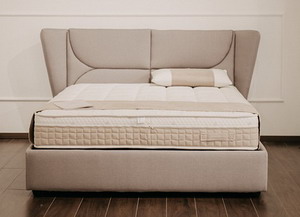 Well, I just hit the button to purchase a new mattress. Yes, I am an armchair shopper. For years I loved going from store to store looking for the best deal and just the right features I wanted. I still like wandering around the Ace Hardware down the street from me just to look at all the cool stuff. I am sure there are many guys out there and more than a few gals that love hardware store stuff. But over the last few years, I have been seduced by the ease and immense variety of stuff available to purchase with a few clicks on the computer. The turning point was a few years back looking for a napkin holder for the dining room table. I went to six different stores in the area looking for such a device and either found nothing or only a couple of options, none of which I liked. But then I got online and found hundreds of napkin holders to choose from. It was glorious, and I was hooked.
Well, I just hit the button to purchase a new mattress. Yes, I am an armchair shopper. For years I loved going from store to store looking for the best deal and just the right features I wanted. I still like wandering around the Ace Hardware down the street from me just to look at all the cool stuff. I am sure there are many guys out there and more than a few gals that love hardware store stuff. But over the last few years, I have been seduced by the ease and immense variety of stuff available to purchase with a few clicks on the computer. The turning point was a few years back looking for a napkin holder for the dining room table. I went to six different stores in the area looking for such a device and either found nothing or only a couple of options, none of which I liked. But then I got online and found hundreds of napkin holders to choose from. It was glorious, and I was hooked.
 Another wonderful thing about internet shopping is the ability to easily get other people’s opinions about particular products. Comparison pages abound and rating stars with comments attached are very useful. I like reading what people didn’t like about a particular product. I have to screen out the obvious whiners and the folks that can’t figure out how to screw in a light bulb. And I accept that sometimes a product will sustain damage in shipping. So I ignore these complaints. But sometimes I find really good critical reviews and even suggestions of better products out there. This is the case with the mattress I just hit the button on. I was intending to simply replace the mattress I bought many years ago with another of the same type. But one review mentioned that although the mattress I have now is great for back and stomach sleepers, another version was better for side sleepers. I sleep on my side. I find that this keeps my throat open and tongue forward enough to avoid snoring and sleep apnea. I checked this claim out with the company website and they said the same thing. So now I am getting the upgraded mattress.
Another wonderful thing about internet shopping is the ability to easily get other people’s opinions about particular products. Comparison pages abound and rating stars with comments attached are very useful. I like reading what people didn’t like about a particular product. I have to screen out the obvious whiners and the folks that can’t figure out how to screw in a light bulb. And I accept that sometimes a product will sustain damage in shipping. So I ignore these complaints. But sometimes I find really good critical reviews and even suggestions of better products out there. This is the case with the mattress I just hit the button on. I was intending to simply replace the mattress I bought many years ago with another of the same type. But one review mentioned that although the mattress I have now is great for back and stomach sleepers, another version was better for side sleepers. I sleep on my side. I find that this keeps my throat open and tongue forward enough to avoid snoring and sleep apnea. I checked this claim out with the company website and they said the same thing. So now I am getting the upgraded mattress.
 Fairly often patients will ask me about the best type of mattress for the health of the back. This subject has actually been studied quite a bit, but you don’t hear much about the research because the answer is no answer. People are so different that there is no one best type of mattress for everyone. A type of mattress that I don’t believe is made any longer was found to be terrible for most folk’s backs was a waterbed hybrid that had water tubes surrounded by a layer of foam. This bed increased back pain all across the board. But regular water beds, spring mattresses, inflatable beds, solid foam mattresses, and futons are all good for some people, but not everyone. The advice I have to give people is to actually try out the mattress in the store for a good ten minutes before you buy it. That is why they have showrooms, so you can try them before buying.
Fairly often patients will ask me about the best type of mattress for the health of the back. This subject has actually been studied quite a bit, but you don’t hear much about the research because the answer is no answer. People are so different that there is no one best type of mattress for everyone. A type of mattress that I don’t believe is made any longer was found to be terrible for most folk’s backs was a waterbed hybrid that had water tubes surrounded by a layer of foam. This bed increased back pain all across the board. But regular water beds, spring mattresses, inflatable beds, solid foam mattresses, and futons are all good for some people, but not everyone. The advice I have to give people is to actually try out the mattress in the store for a good ten minutes before you buy it. That is why they have showrooms, so you can try them before buying.
 Two primary factors that come into play with your individuality in mattress choice are the shape of your sacroiliac joint and your weight/body weight distribution. You want good support for the various parts of your body. Some people have a very straight sacroiliac joint in the pelvis which leads to a naturally straight spine. Such people generally find a firmer bed to be more evenly supportive. Other people have a more L-shaped sacroiliac joint producing a spine with a lot of curves to it. These people generally like a softer bed that adapts to the curves better than a firm bed. This same concept comes into play with weight distribution. If your weight is all in your hips and you have a narrow waist, you will have those same curves to deal with compared to someone whose weight distribution is even all over.
Two primary factors that come into play with your individuality in mattress choice are the shape of your sacroiliac joint and your weight/body weight distribution. You want good support for the various parts of your body. Some people have a very straight sacroiliac joint in the pelvis which leads to a naturally straight spine. Such people generally find a firmer bed to be more evenly supportive. Other people have a more L-shaped sacroiliac joint producing a spine with a lot of curves to it. These people generally like a softer bed that adapts to the curves better than a firm bed. This same concept comes into play with weight distribution. If your weight is all in your hips and you have a narrow waist, you will have those same curves to deal with compared to someone whose weight distribution is even all over.
 One type of bed that is very popular and very expensive is the type that bends so the head and knee area prop up. Although this might be very comfortable to relax in, it is a bad idea for the spine. Your spine needs to spend a full night without any weight-bearing pressure on it. If you are sitting up even a bit, gravity is pushing the spinal vertebra together. Between each vertebra is a soft cushion called a spinal disc. These discs hold the vertebra in proper alignment and provide the space between the vertebra for the nerves to exit and go to and from the body. These discs are filled with a water-based gel that gets the water squeezed out of it over the course of the day by gravity squeezing down on each disc. Nighttime is when these discs are supposed to fill back up with water. At night the pressure is off the discs so the gel can slowly suck up more water for the next day. If you are sleeping partially upright, your discs will not return to their full size and the joint spaces get smaller. That means less room for the nerves and greater opportunity for nerve compression and the resultant pain it produces.
One type of bed that is very popular and very expensive is the type that bends so the head and knee area prop up. Although this might be very comfortable to relax in, it is a bad idea for the spine. Your spine needs to spend a full night without any weight-bearing pressure on it. If you are sitting up even a bit, gravity is pushing the spinal vertebra together. Between each vertebra is a soft cushion called a spinal disc. These discs hold the vertebra in proper alignment and provide the space between the vertebra for the nerves to exit and go to and from the body. These discs are filled with a water-based gel that gets the water squeezed out of it over the course of the day by gravity squeezing down on each disc. Nighttime is when these discs are supposed to fill back up with water. At night the pressure is off the discs so the gel can slowly suck up more water for the next day. If you are sleeping partially upright, your discs will not return to their full size and the joint spaces get smaller. That means less room for the nerves and greater opportunity for nerve compression and the resultant pain it produces.
 During my preteen and teen years, I slept on a foam rubber mattress. I loved it. Once I got out of college, I looked for a similar mattress to use in my adult years. Unfortunately, the foam mattresses of my youth no longer existed. It seems that foam rubber had the unfortunate tendency to turn into a blazing furnace if someone allowed their cigarette to fall onto the mattress. I never smoked, so I had not noticed this flaw. A government agency had an issue with flaming beds and put a stop to their manufacture. Consequently, foam rubber beds became relics of a glorious past of sleeping comfort. As a result, I ended up with a water bed. It was the 70s and water beds were the cool new kids on the block. My first one even had a fake fur frame around it!
During my preteen and teen years, I slept on a foam rubber mattress. I loved it. Once I got out of college, I looked for a similar mattress to use in my adult years. Unfortunately, the foam mattresses of my youth no longer existed. It seems that foam rubber had the unfortunate tendency to turn into a blazing furnace if someone allowed their cigarette to fall onto the mattress. I never smoked, so I had not noticed this flaw. A government agency had an issue with flaming beds and put a stop to their manufacture. Consequently, foam rubber beds became relics of a glorious past of sleeping comfort. As a result, I ended up with a water bed. It was the 70s and water beds were the cool new kids on the block. My first one even had a fake fur frame around it!
 We spend a third of our life in bed, so it serves us to find a bed that really works for us. I have my fingers crossed for the new bed I just ordered, but you never know with internet purchases as you can’t try them out beforehand. Another way to enhance your bedtime experience is to make sure you don’t have any source of light in your bedroom while you sleep. That means no night lights. I have one faint light source in the form of a digital clock with red glowing numbers, however, it’s located on the dresser beyond the foot of the bed. The red glow is the color that disturbs your sleep the least. I recommend that you do not have any electronics in your bedroom at all. Some people are very reactive to electronics, but all of us have some level of sensitivity to them. This is especially impactful during our sleep hours.
We spend a third of our life in bed, so it serves us to find a bed that really works for us. I have my fingers crossed for the new bed I just ordered, but you never know with internet purchases as you can’t try them out beforehand. Another way to enhance your bedtime experience is to make sure you don’t have any source of light in your bedroom while you sleep. That means no night lights. I have one faint light source in the form of a digital clock with red glowing numbers, however, it’s located on the dresser beyond the foot of the bed. The red glow is the color that disturbs your sleep the least. I recommend that you do not have any electronics in your bedroom at all. Some people are very reactive to electronics, but all of us have some level of sensitivity to them. This is especially impactful during our sleep hours.
 Another very useful condition is to sleep in a cool room. This greatly enhances sleep quality. Some authors even recommend sleeping in a 50-degree room at night. I find this too cold, even with several blankets. I tend to get hot flashes at night which means I tend to throw off my blankets for a while as I try to sleep. If you have the option of a sleep partner, a side benefit to sleeping in a cool room is the pleasant warmth of snuggling up to him or her while falling asleep. The downside to a sleep partner is the night music, otherwise known as snoring, that they might serenade you with. Ear plugs are a viable solution for such situations. The trick is to find comfortable earplugs.
Another very useful condition is to sleep in a cool room. This greatly enhances sleep quality. Some authors even recommend sleeping in a 50-degree room at night. I find this too cold, even with several blankets. I tend to get hot flashes at night which means I tend to throw off my blankets for a while as I try to sleep. If you have the option of a sleep partner, a side benefit to sleeping in a cool room is the pleasant warmth of snuggling up to him or her while falling asleep. The downside to a sleep partner is the night music, otherwise known as snoring, that they might serenade you with. Ear plugs are a viable solution for such situations. The trick is to find comfortable earplugs.
 That is pretty much my story and resource information about beds. I wish I could say that there is one best type of bed that everyone should sleep on, but I can’t. We are all so different. So we embrace that and look for what works best for us.
That is pretty much my story and resource information about beds. I wish I could say that there is one best type of bed that everyone should sleep on, but I can’t. We are all so different. So we embrace that and look for what works best for us.
Take care,
David
